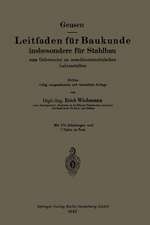Piping and Pipeline Calculations Manual: Construction, Design Fabrication and Examination
Autor Philip Ellenbergeren Limba Engleză Paperback – 5 apr 2014
Aside from advising on the intent of codes and standards, the book provides advice on compliance. Readers will come away with a clear understanding of how piping systems fail and what the code requires the designer, manufacturer, fabricator, supplier, erector, examiner, inspector, and owner to do to prevent such failures. The book enhances participants' understanding and application of the spirit of the code or standard and form a plan for compliance.
The book covers American Water Works Association standards where they are applicable.
- Updates to major codes and standards such as ASME B31.1 and B31.12
- New methods for calculating stress intensification factor (SIF) and seismic activities
- Risk-based analysis based on API 579, and B31-G
- Covers the Pipeline Safety Act and the creation of PhMSA
Preț: 478.75 lei
Preț vechi: 626.58 lei
-24% Nou
Puncte Express: 718
Preț estimativ în valută:
91.62€ • 95.30$ • 75.64£
91.62€ • 95.30$ • 75.64£
Carte tipărită la comandă
Livrare economică 07-21 aprilie
Preluare comenzi: 021 569.72.76
Specificații
ISBN-13: 9780124167476
ISBN-10: 0124167470
Pagini: 412
Ilustrații: black & white illustrations, black & white tables, figures
Dimensiuni: 152 x 229 x 25 mm
Greutate: 0.64 kg
Ediția:2 Rev ed.
Editura: ELSEVIER SCIENCE
ISBN-10: 0124167470
Pagini: 412
Ilustrații: black & white illustrations, black & white tables, figures
Dimensiuni: 152 x 229 x 25 mm
Greutate: 0.64 kg
Ediția:2 Rev ed.
Editura: ELSEVIER SCIENCE
Public țintă
Piping Engineers, Designers, Civil Engineers, Mechanical Engineers, Petroleum Engineers and Chemical EngineersCuprins
Chapter 1: Major Codes and Standards?Chapter 2: Metric versus U.S. Customary Measurement?Chapter 3: Selection and Use of Pipeline Materials?Chapter 4: Piping and Pipeline Sizing, Friction Losses, and Flow Calculations?Chapter 5: Piping and Pipeline Pressure Thickness Integrity Calculations?Chapter 6: Straight Pipe, Curved Pipe, and Intersection Calculations?Chapter 7: Piping Flexibility, Reactions, and Sustained Thermal CalculationsChapter 8: Pipe-Supporting Elements and Methods Calculations?Chapter 9: Specialty Components?Chapter 10: High-Frequency versus Low-Frequency Vibration Calculations?Chapter 11: Occasional Loads Calculations?Chapter 12: Slug Flow and Fluid Transients Calculations?Chapter 13: Fabrication and Examination Elements Calculations?Chapter 14: Valves and Flow Control Calculations?
Recenzii
"This monograph serves as a guide to the principle intentions of the piping systems codes or standards and provides advice on compliance. The author demonstrates a clear understanding of how piping fail and what the code systems requires the designer, manufacturer, fabricator, supplier, erector, examiner, inspector, and owner to do to prevent such failures. The focus of the book is to enhance participants' understanding and application of the spirit of the code or standard and form a plan for compliance. The book is enhanced by a multitude of calculations to assist in problem solving, directly applying the rules and equations for specific design and operating conditions to illustrate correct applications." --MCEER






















